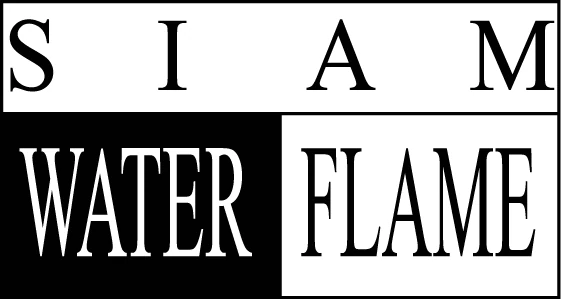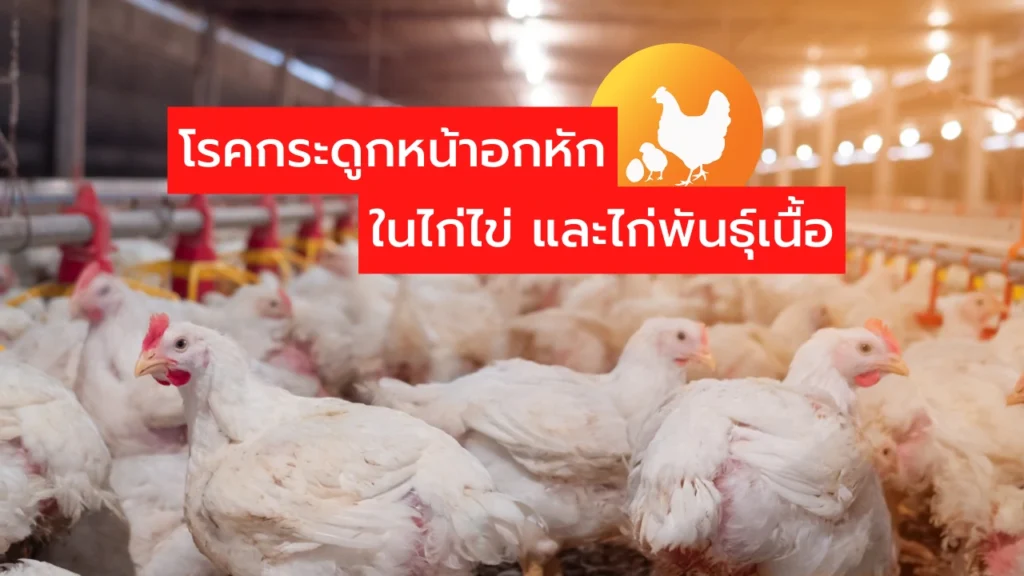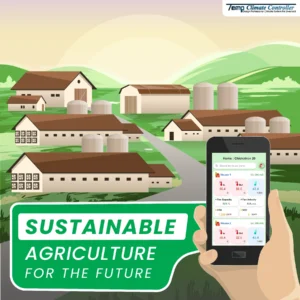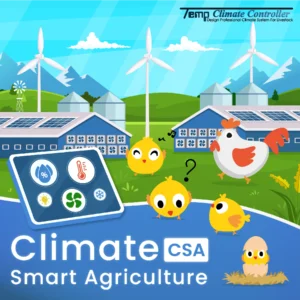Bone fracture Disease in laying hens and broilers..
Keel bone fractures (KBF) are a health and welfare issue for animals. The most common in raising laying hens. broken heart disease It has an important feature. new bone tissue formation (callus formation)
which is a common lesion in hens that are raised without driving the city or notice a broken mark and/or fracture or fracture of the sternum (keel) or anatomical term called “sternum”. This problem can be found all over the world. in laying hens in all systems commercial egg production The cause of osteoarthritis in hens during laying still an issue
controversial in academic circles and the exact cause is still unclear.
Fractures in laying hens.
Heart fracture in laying hens is a major animal welfare problem as it results in injury and suffering to animals. causing animals to reduce their mobility and affect their quality of life and output directly from poor food exchange efficiency egg laying rate and decreased egg quality after the claim The FAWC committee recommends starting with studying trends in disease prevalence.
according to the offer Plan audits for both laying hens and hens at the slaughterhouse, possibly every time. or systematic random sampling by palpation and/or assessment of the sternum after excision from the animal. Various research works
Began publishing in academic journals.
An experiment with deslorelin acetate, which inhibits egg laying, found that hens fed with this substance did not have fractures of the heart. Natural gonadotropin releasing hormone. This hormone is secreted from the hypothalamus of the brain. It is responsible for regulating the functioning of the endogenous glands.
tubes inside animal bodies This hormone also stimulates the pituitary gland to secrete follicle stimulating hormone (FSH).
and luminizing hormone (Luteinizing hormone, LH). Found an association between broken heart disease and giving the first egg too early small hen and the average egg weight in the first batch, while the scholars noted that the male chickens did not have heart fractures, indicating a relationship between this disease and egg production. abnormalities of the sternum It can be classified as destruction, deformation, and fracture of the bone.
By classifying the causes of such anomalies as The destruction of the deformity of the sternum is mainly caused by the behavior of perching. and hard perch or too thin while fracture of the sternum is the result of impact with the house structure
Fractures in broiler chickens
Chakomodo Krokkalnnel Breeding hens for broiler chick production or broiler chicken It produces eggs just like laying hens. Can be found in broiler hens. Likewise, egg laying in broilers is slower than laying hens. and not producing a large number of eggs As much as laying hens. In addition, broilers have a larger structure. and much larger chest muscles help protect the sternum and reduce the risk of this disease.
Because body size is associated with heart fractures A recent research report found that the prevalence of osteoarthritis in mature broiler breeds, both fast growing and slow growing breeds, in Ross 308, Ranger Gold and Hubbard JA 757 was between 14%. to 54 lower than previously reported in commercially raised layer hens with a prevalence between 85% and 99%.
by explaining the cause As for the prevalence of disease in broiler chickens which is lower than that of laying hens, It may be related to the age of egg onset. Lower egg laying rates and faster laying times (63 weeks broiler shed age compared to 75 laying hens
Conclusion
Broken heart disease is an issue in Animal welfare in chickens during egg production in both laying hens and breeding hens after the board farm animal welfare The UK urges poultry producers to recognize the importance of this problem as it causes great pain and suffering to animals. Therefore, more and more research reports related to heart fractures are published, especially methods for examination, assessment of the disease and studies of the true prevalence of the disease.
Data source: Land Animal Magazine, issue 357 January 2023
Bone fracture disease in laying hens and broilers..
Keel bone fractures (KBF) are a health and welfare issue for animals. The most common in raising laying hens. broken heart disease It has an important feature. new bone tissue formation (callus formation)
which is a common lesion in hens that are raised without driving the city or notice a broken mark and/or fracture or fracture of the sternum (keel) or anatomical term called “sternum”. This problem can be found all over the world. in laying hens in all systems commercial egg production The cause of osteoarthritis in hens during laying still an issue
controversial in academic circles and the exact cause is still unclear.
Fractures in laying hens.
Heart fracture in laying hens is a major animal welfare problem as it results in injury and suffering to animals. causing animals to reduce their mobility and affect their quality of life and output directly from poor food exchange efficiency egg laying rate and decreased egg quality after the claim The FAWC committee recommends starting with studying trends in disease prevalence. according to the offer Plan audits for both laying hens and hens at the slaughterhouse, possibly every time. or systematic random sampling by palpation and/or assessment of the sternum after excision from the animal. Various research works
Began publishing in academic journals.
An experiment with deslorelin acetate, which inhibits egg laying, found that hens fed with this substance did not have fractures of the heart. Natural gonadotropin releasing hormone. This hormone is secreted from the hypothalamus of the brain. It is responsible for regulating the functioning of the endogenous glands.
tubes inside animal bodies This hormone also stimulates the pituitary gland to secrete follicle stimulating hormone (FSH).
and luminizing hormone (Luteinizing hormone, LH). Found an association between broken heart disease and giving the first egg too early small hen and the average egg weight in the first batch, while the scholars noted that the male chickens did not have heart fractures, indicating a relationship between this disease and egg production. abnormalities of the sternum It can be classified as destruction, deformation, and fracture of the bone. By classifying the causes of such anomalies as The destruction of the deformity of the sternum is mainly caused by the behavior of perching. and hard perch or too thin while fracture of the sternum is the result of impact with the house structure
Fractures in broiler chickens
Chakomodo Krokkalnnel Breeding hens for broiler chick production or broiler chicken It produces eggs just like laying hens. Can be found in broiler hens. Likewise, egg laying in broilers is slower than laying hens. and not producing a large number of eggs As much as laying hens. In addition, broilers have a larger structure. and much larger chest muscles help protect the sternum and reduce the risk of this disease.
Because body size is associated with heart fractures A recent research report found that the prevalence of osteoarthritis in mature broiler breeds, both fast growing and slow growing breeds, in Ross 308, Ranger Gold and Hubbard JA 757 was between 14%. to 54 lower than previously reported in commercially raised layer hens with a prevalence between 85% and 99%.
by explaining the cause As for the prevalence of disease in broiler chickens which is lower than that of laying hens, It may be related to the age of egg onset. Lower egg laying rates and faster laying times (63 weeks broiler shed age compared to 75 laying hens
Conclusion
Broken heart disease is an issue in Animal welfare in chickens during egg production in both laying hens and breeding hens after the board farm animal welfare The UK urges poultry producers to recognize the importance of this problem as it causes great pain and suffering to animals. Therefore, more and more research reports related to heart fractures are published, especially methods for examination, assessment of the disease and studies of the true prevalence of the disease.
Data source: Land Animal Magazine, issue 357 January 2023
.
Bone fracture disease in laying hens and broilers..
Keel bone fractures (KBF) are a health and welfare issue for animals. The most common in raising laying hens. broken heart disease It has an important feature. new bone tissue formation (callus formation)
which is a common lesion in hens that are raised without driving the city or notice a broken mark and/or fracture or fracture of the sternum (keel) or anatomical term called “sternum”. This problem can be found all over the world. in laying hens in all systems commercial egg production The cause of osteoarthritis in hens during laying still an issue
controversial in academic circles and the exact cause is still unclear.
Fractures in laying hens.
Heart fracture in laying hens is a major animal welfare problem as it results in injury and suffering to animals. causing animals to reduce their mobility and affect their quality of life and output directly from poor food exchange efficiency egg laying rate and decreased egg quality after the claim The FAWC committee recommends starting with studying trends in disease prevalence.
according to the offer Plan audits for both laying hens and hens at the slaughterhouse, possibly every time. or systematic random sampling by palpation and/or assessment of the sternum after excision from the animal. Various research works
Began publishing in academic journals.
An experiment with deslorelin acetate, which inhibits egg laying, found that hens fed with this substance did not have fractures of the heart. Natural gonadotropin releasing hormone. This hormone is secreted from the hypothalamus of the brain. It is responsible for regulating the functioning of the endogenous glands.
tubes inside animal bodies This hormone also stimulates the pituitary gland to secrete follicle stimulating hormone (FSH).
and luminizing hormone (Luteinizing hormone, LH). Found an association between broken heart disease and giving the first egg too early small hen and the average egg weight in the first batch, while the scholars noted that the male chickens did not have heart fractures, indicating a relationship between this disease and egg production. abnormalities of the sternum It can be classified as destruction,
deformation, and fracture of the bone. By classifying the causes of such anomalies as The destruction of the deformity of the sternum is mainly caused by the behavior of perching. and hard perch or too thin while fracture of the sternum is the result of impact with the house structure
Fractures in broiler chickens
Chakomodo Krokkalnnel Breeding hens for broiler chick production or broiler chicken It produces eggs just like laying hens. Can be found in broiler hens. Likewise, egg laying in broilers is slower than laying hens. and not producing a large number of eggs As much as laying hens. In addition, broilers have a larger structure. and much larger chest muscles help protect the sternum and reduce the risk of this disease.
Because body size is associated with heart fractures A recent research report found that the prevalence of osteoarthritis in mature broiler breeds, both fast growing and slow growing breeds, in Ross 308, Ranger Gold and Hubbard JA 757 was between 14%. to 54 lower than previously reported in commercially raised layer hens with a prevalence between 85% and 99%.
by explaining the cause As for the prevalence of disease in broiler chickens which is lower than that of laying hens, It may be related to the age of egg onset. Lower egg laying rates and faster laying times (63 weeks broiler shed age compared to 75 laying hens
Conclusion
Broken heart disease is an issue in Animal welfare in chickens during egg production in both laying hens and breeding hens after the board farm animal welfare The UK urges poultry producers to recognize the importance of this problem as it causes great pain and suffering to animals. Therefore, more and more research reports related to heart fractures are published, especially methods for examination, assessment of the disease and studies of the true prevalence of the disease.
Data source: Land Animal Magazine, issue 357 January 2023
.












